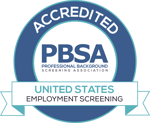
Employers use Employment Eligibility Verification to confirm the identity of a new employee and verify he or she is eligible to be employed in the US.
All employers do this by completing Form I-9. Many also electronically verify eligibility with DHS and SSA through E-Verify.
Who are the key agencies for Employment Eligibility Verifications?
The United States Department of Homeland Security and the Social Security Administration, DHS and SSA respectively, are responsible for confirming that all information submitted via E-Verify matches. When E-Verify returns a Tentative Non-Confirmation, or TNC, the issue is addressed directly with DHS and/or SSA by the employee.
The United States Citizenship and Immigration Services, or USCIS, manages E-Verify and Form I-9. For example, USCIS revises Form I-9 (the most recent of which was March 2016). USCIS is also responsible for issuing federal identification documents, such as a Green Card.
Lastly, enforcement of Form I-9 and E-Verify is managed by ICE, the US Immigration and Customs Enforcement. ICE Auditors will review an employer’s documents and practices to determine if regulatory violations exist and will impose penalties including fines and jail.
Using Form I-9 vs. E-Verify
Do you remember philosophy class? It’s actually relevant to real life in that Form I-9 can exist without E-Verify, but E-Verify cannot exist without Form I-9.
What does this mean?
All employers are required to complete Form I-9 for all new hires since Richard Nixon authorized the Immigration Reform and Control Act of 1986. E-Verify then uses the information provided on Form I-9 to confirm identity and employment eligibility directly with DHS and SSA.
Because E-Verify uses Form I-9, Form I-9 must be completed in order to proceed with E-Verify. Conversely, E-Verify is not always required just because you completed Form I-9.
Verifying Employment Eligibility
After the employee has completed Section 1 of Form I-9, the employer is responsible for Section 2 to verify identity and employment eligibility.
When completing Section 2, you are not expected to be an expert in identification documents, such as Work Visas, passports, and driver’s licenses. Rather, you’re expected to make a decision that the document(s) look reasonably authentic.
Once you’ve made this determination, you can proceed with completing Section 2 of Form I-9.
If you are enrolled in E-Verify, you will take verification a step further by confirming identity and eligibility directly with SSA and DHS, keeping in mind E-Verify is in no way a replacement for Form I-9.
Penalties for not verifying Employment Eligibility
It is a best practice to understand all risks and penalties associated with employment eligibility verification compliance.
Here’s some key penalties all employers should be aware of:
Errors and Omissions
Minor mistakes, improper edit annotation to a previously completed Form, and others will result in fines to employers. Nearly every field and nearly every action taken to complete Form I-9 or E-Verify can carry a fine for doing something wrong.
Missing Forms and Forms that should have been purged
Intentional or accidental, missing Forms on any employee is a finable offense. Similarly, if you could have thrown away a form (for example, employment terminated over 3 years ago) but didn’t, you could be fined if that form has an error.
Inconsistency
It’s vital that employers maintain consistent practices when completing Forms I-9 and E-Verify. And, should your process change, the change should be clearly documented.
These are some of the inconsistencies that could easily land you in trouble:
Making copies of identification documents for some employees and not others
Only making copies of certain documents
Using E-Verify for some people and not others
Unlawful Employment
Penalties are clearly stated for those who employ unauthorized individuals – both criminal and civil.
According to USCIS, penalties for criminal violations of “engaging in a pattern or practice of hiring, recruiting or referring for a fee unauthorized aliens” can face fines of $3,000 for each unauthorized alien and up to 6 months in prison.
Civil penalties for the same unlawful employment activity max out at $16,000 per worker for the third offense.
Discrimination
When employers discriminate against employment-authorized individuals, you are subject to the same civil penalties tiers as employing unauthorized employees - $375 for the first offense) to $16,000 for the third offense per violation.
Not using E-Verify when it’s required
For the vast majority of employers, E-Verify is voluntary. However, specific industries (such as farming) and jurisdictions (like Texas) require E-Verify. All federal contractors with a FAR-Clause, all federal employees and many municipal employees must also be E-Verified.
Belonging to any category in which E-Verify is required substantially increases your vulnerability to an ICE audit.
Who knew?
Who knew a Form that is so simple it’s almost habitual and an online app many of us don’t even use could cost tens of thousands.
Don't worry - there's hope!
Since Form I-9 ComplyTM (our online Form I-9 management tool) has been in use, audited employers have virtually eliminated errors and omissions on Forms submitted through I-9 ComplyTM. Those using the tool spend less energy worrying about nuances and more time focused on the bigger picture – adequate training, solid policy and avoiding discrimination.


